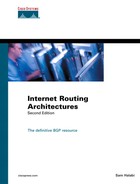Frequently Asked Questions
Q— If my IBGP peers are not directly connected, do I have to use EBGP multihop?
A— No. There is no restriction on IBGP peers to be connected. EBGP multihop is for EBGP only.
Q— Should I inject my BGP routes into the IGP for synchronization to take effect?
A— No. Injecting the BGP into your IGP is not recommended. You should turn the BGP synchronization off. Make sure that this will not result in reachability problems inside your AS.
Q— Will listing my IGP routes via the network command rather than redistributing the IGP into BGP give my BGP routes more stability?
A— No. In both methods, the fluctuation of your IGP routes will translate into fluctuation in your BGP routes. The network command only gives you better control and less worry about what your IGP might distribute into BGP if you use redistribution. Combine it with static routes (with distance 254, for example) to Null0 if you want to prevent route fluctuation even if your IGP routing is not stable.
Q— Do I have to list my connected interfaces by using the network command?
A— If you want the directly connected subnets to be reachable via BGP, you can advertise them. If not, you don't have to.
Q— I have two border routers talking EBGP to my provider and IBGP internally. If I list my IGP routes via the network command on both routers, would that create a loop on the IBGP session?
A— No, you will not create a loop. Actually, doing so gives you more redundancy. If one of your border routers fails, the other border router will still announce the same networks.
Q— I need to receive only a few routes from my neighbor. Can I filter on my side of the link?
A— Yes, you can. However, you should ask your neighbor to send you only the routes you need to minimize unnecessary link bandwidth usage and unnecessary route fluctuations. At the same time, use filtering on your end to protect yourself from potential accidents in which your neighbor sends you more routes than you are expecting.
Q— My provider needs me to send him different local preference on different links. Is that possible?
A— No. Local preference is defined inside the AS and is not carried on EBGP sessions. However, a more optimal solution might be to ask your provider to set up a route map that does a match based on BGP community strings (such as those defined in RFC 1998), on his side of the peering session, to set the local preference for your routes in his AS. You will have to tag your routes with the appropriate community string in order for the local preference to be set correctly by his peer session. You could also use MEDs for this.
Q— I am receiving a MED from my provider that is influencing my traffic in a way that conflicts with my IGP. What should I do?
A— If receiving MEDs is causing you problems, call your provider and ask him to stop sending MEDs. Or, you can set MED to 0 on your end of the session.
Q— I am connected to multiple providers. On some occasions, my AS is hit with an enormous amount of traffic that does not belong to my AS. What could be wrong?
A— You might be advertising routes that you receive from one provider to other providers. Other ASs might be using your AS as transit for their traffic. Make sure that you advertise only your routes to your providers.
Q— I am multihomed to the same provider. Do I have to worry about advertising the routes I learn from one link back on the second link?
A— Presumably, BGP policies on your provider's end will detect the routes it is receiving from you that have already passed through its AS and will ignore them. Nevertheless, this is bad practice. By doing so, you're unnecessarily consuming CPU and link resources with useless information; if possible, make sure that you send your own routes only.
Q— I am a provider, and I have given one of my customers a private AS number. Now, the customer wants to have a different connection with another provider. What would happen if he keeps using the private AS number?
A— Though this does occur in the Internet today, it is considered a very undesirable configuration. After you advertise this customer's network to the Internet, you are stripping the private AS number and announcing the routes as if they originated from your own AS. If the second provider does the same thing, the customer's networks will be originated from two unique ASs, potentially resulting in routing loops. Also, if any type of aggregation is performed on the customer address before it is announced to other networks, it could result in a more-specific route's being available via one of the two providers, thereby removing the potential for load sharing between the connections. If the customer cannot obtain a global AS number from the appropriate RIR, he should ensure that both providers thoroughly coordinate and provide adequate details regarding load sharing and failover scenarios associated with the configuration.
Q— I am connected to one provider in San Francisco, and I am advertising my routes via BGP. I am connecting to another provider in LA. Should I get a different AS number?
A— If both the SF and LA networks fall under the same administration and have the same policies with other ASs, they belong in the same AS. Remember that dividing networks via BGP is to define the boundaries of administration and policy. Network topology and connectivity should be the driving factor.
